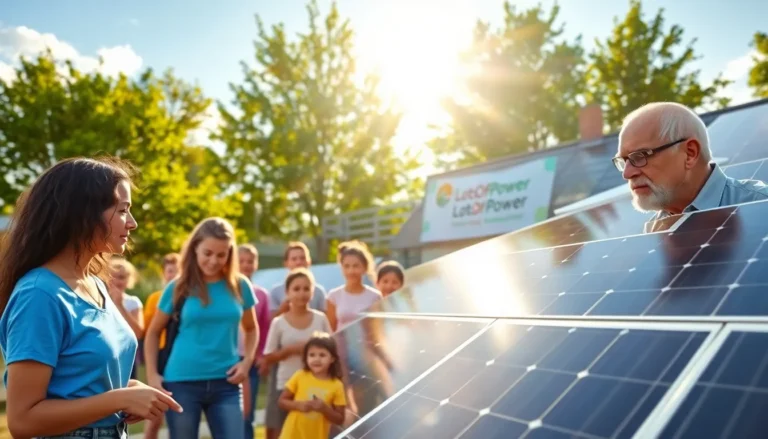Table of Contents
ToggleIn a world rapidly cooking under the sun, green tech innovations serve as our lifeboats. Are they truly saving the planet or just giving us a pretty picture while we sink? With all the buzz around renewable energy and sustainable practices, it’s easy to get lost in a sea of jargon and flashy headlines. Don’t worry. Today, we dive deep into how these innovations are reshaping our environment, proving not only beneficial but essential in our quest for a sustainable future. Buckle up. You’re about to discover how technology isn’t just saving us time and money, it’s also potentially rescuing our dear planet from its own excessive partying.
Overview of Green Technology

Green technology encompasses a variety of practices, materials, and systems designed to reduce environmental impact. At its core, this technological approach aims to promote sustainability through several means, including reducing carbon footprint, conserving resources, and harnessing renewable energy sources. Technologies such as solar panels, wind turbines, and biofuels all contribute to this eco-friendly revolution.
Unlike traditional technology that often exploits natural resources, green technology seeks alternatives that assist in preserving our planet. The innovation doesn’t stop at energy production: it extends to agriculture, transportation, and everyday consumer products. In essence, green technology is the intersection of progress and preservation, forming the backbone of a cleaner, greener society.
Importance of Green Tech Innovations
Why should society invest in green tech? The short answer is that our survival hinges on it. Climate change is no longer a future scenario: it’s a present reality, raising the stakes for immediate action. Green tech innovations act as catalysts for this transformation.
The economic implications are also crucial. Investing in green technology often leads to job creation in emerging industries. Renewable energy sectors alone have been known to generate positions that outnumber those in fossil fuel industries, showing that saving the planet can translate to economic growth. Also, technological advancements are making green solutions increasingly cost-effective, proving that green doesn’t always mean greenbacks. Investing in clean energy reduces dependency on imported fuels and mitigates energy price volatility.
Eventually, the importance of green tech innovations lies in their ability to address pressing environmental concerns while simultaneously providing pathways for economic improvement and energy independence.
Key Innovations in Green Technology
In exploring green tech, it’s essential to break down the primary innovations making waves in this space. Numerous advancements stand out as the future harbingers of sustainable living. Let’s examine the key sectors driving these changes in detail.
Renewable Energy Solutions
Renewable energy solutions are at the forefront of green technology. Solar, wind, hydroelectrics, and geothermal energy serve as the backbone of a sustainable energy strategy. For instance, solar panels are now more efficient and affordable than ever. Recent breakthroughs allow for energy storage options that can harness excess energy for future use. Wind turbines have also evolved, with smart technology predicting wind patterns to optimize energy production.
Energy-Efficient Buildings
In the quest for sustainability, energy-efficient buildings play a significant role. Innovations like smart thermostats and energy-efficient lighting have become standard in modern construction. These buildings not only reduce energy consumption but also embrace sustainable materials and green roofs, enhancing biodiversity in urban environments.
Sustainable Agriculture Practices
Sustainable agriculture practices, including vertical farming and organic farming techniques, are revolutionizing food production. Emphasizing minimal use of chemicals and resources, these methods not only yield high-quality produce but also promote soil health and water conservation. Besides, aquaponics and permaculture principles are being integrated into mainstream practices, showcasing a harmonious relationship between farming and nature.
Waste Management and Recycling Technologies
Waste management and recycling technologies make up another critical area in green tech innovation. Advanced sorting systems and composting technologies ensure that waste is handled sustainably. Innovations like biodegradable packaging and waste-to-energy plants are also emerging, turning trash into treasure.
Challenges and Opportunities in Green Technology
Even though the numerous benefits, the green tech field faces challenges. One significant issue is the upfront cost of implementing green technologies. While long-term savings abound, the initial investments can deter adoption, especially by smaller enterprises.
Also, regulatory landscapes are often slow to adapt, lagging behind rapid technological advancements. Governments must revisit policies to create supportive environments for green innovations. But, these challenges also present opportunities. With rising public awareness surrounding environmental issues, there is a growing demand for green solutions that companies can capitalize on.
Investors are also increasingly drawn to sustainable technologies, leading to a wealth of funding options for innovative startups. The synergy between public interest and private capital opens doors to unprecedented advancements in green tech.
Future Trends in Green Tech Innovations
As green tech continues to evolve, several trends are set to shape the future of this field. One notable trend is the rise of artificial intelligence in optimizing energy consumption patterns. AI can analyze vast amounts of data to recommend energy-efficient practices tailored for different sectors.
Also, the integration of blockchain technology for transparency in renewable energy transactions is gaining traction. This can streamline energy distribution while ensuring sustainability metrics are met. Such technologies aim to foster trust in green initiatives and motivate users to adopt sustainable practices.
Besides, as climate change conversations shift toward adaptation strategies, innovations in climate-resilient infrastructure will also gain importance. Technologies aimed at disaster preparedness and resource management will likely see a surge in demand, highlighting an ever-evolving landscape of opportunities.







